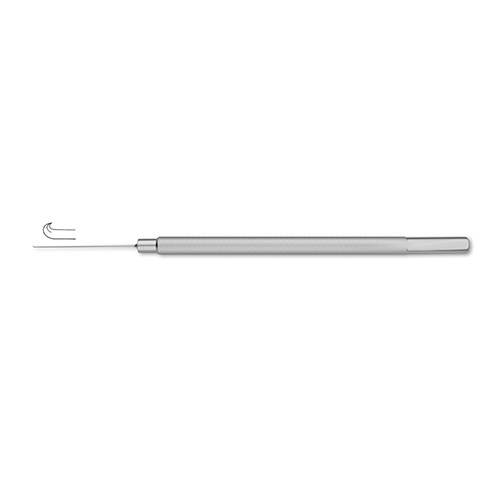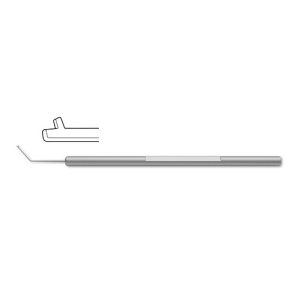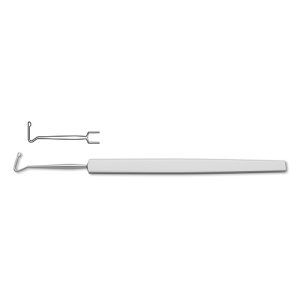| Name | Sheets Iris Hook |
| Lead Time | Lead time advised within 48 hours of order placement. |
| Competitor | ;OP0923001;OP0923-001;601327;60-1327;6013-27; |
| Specialty | Ophthalmology-Hooks & Manipulators |
| Material Finish | Stainless Steel |
| Grade | Premium Operating Room |
| Units of Measurement | Each |
| Manufacturer | Medicrest Surgical Industries |
| Sterility | Non-Sterile |
| Usage | Reusable |
Sheets Iris Hook
0.3 mm hook w/ guard, 5-1/8″ (13.0 cm) Sheets Iris Hook is a commonly used tool during cataract procedures and operations needing access to the lens capsule. The 0.3mm hook provides extra fine control in retracting only the desired portion of iris. In addition, the hook comes available with a guard to protect from damaging surrounding tissue.
SKU:
MSI-05-1190
Category: Hooks &Manipulators
Description
Reviews (0)
Be the first to review “Sheets Iris Hook” Cancel reply
Shipping & Delivery
Related products
Burch Fixation Pick
Crawford Retrieving Hook
round handle, 5-5/8" (14.3 cm) Crawford Retrieving Hook is a frequently used tool in occuloplastic procedures. The hook is used primarily to engage a silicone shut placed through the lacrimal apparatus from the nose. The extended length of the hook is designed to accommodate a variety of patient sizes.
Double Fixation Hook
5-1/4" (13.5 cm) Double Fixation Hook is a useful tool in ophthalmic and occuloplastic procedures. The instrument may be used to atraumatically fix the lid or other skin flaps for manipulation of deeper tissues. Two different hook widths are available depending on surgical preference and patient variation.
Fenzel Lens Manipulator
10.0 mm shaft w/ 0.2 mm t-shaped hook, 4-3/4" (12.0 cm) Fenzel Lens Manipulator is a commonly used tool during cataract procedures. The manipulator features an additional stabilizing bar on the tip to aid in controlling the lens to an appropriate position for extraction. Both straight and angled models are available depending on surgical preference.
Jameson Muscle Hook
5-1/8" (13.0 cm) Jameson Muscle Hook is a useful tool in performing strabismus or other ophthalmologic procedures involving the ocular muscles. The hook can be used to elevate the muscle tissue for dissection and reattachment. The rounded tip ensures atraumatic entrance underneath the desired muscle. Two different sizes are available with the hook depending on surgical preference.
Koch Stop & Chop Manipulator
angled shaft w/ 1.5 mm tip, 4-1/3" (11.2 cm) Koch Stop & Chop Manipulator is a tool used exclusively for cataract procedures. The manipulator is used to facilitate the stop and chop technique, in which the lens nucleus is initially sculpted and then chopped into smaller pieces for extraction. The angled shaft aids in accessing the lens capsule.
Osher Nucleus Manipulator
smaller than 60-1313, 0.5 mm two-prong tip, blunt, 4-1/2" (11.5 cm) Osher Nucleus Manipulator is a useful tool for cataract procedures. The tool can be used to shift the center of the lens to a proper surgical position if it slips underneath the surrounding iris tissue. The two prong blunt tip is ideal for easy manipulation without risk of damaging surrounding tissue.
Shepard Iris Hook
1.0 mm, blunt, 4-7/8" (12.4 cm) Shepard Iris Hook is a commonly used tool in cataract surgeries. The hook is used to retract a portion of the iris tissue to gain access to the lens capsule. Often, multiple hooks are used at different positions around the iris and anchored, providing adequate visualization for lens removal. The hook features a blunt tip to minimize extraneous tissue damage.










Reviews
There are no reviews yet.